Table of Contents
Project at a Glance | |
Project Name | Delhi Mumbai Expressway |
Project Type | Greenfield |
Sector | Infrastructure |
Subsector | Expressway (Road Transport) |
Project Value | INR 98000 crore (USD 11.72 billion) |
Project Status | Under construction |
Starting Point | DND Flyway in Delhi and Sohna in Haryana |
Terminal | Virar and Jawaharlal Nehru Port Trust, Maharastra |
Project Developer | National Highways Authority of India (NHAI) |
Project Start Date | 2019 |
Project Commissioned Date | March 2026 |
Special Mention | The longest expressway in India |
Project Overview
The Delhi-Vadodara-Mumbai Expressway will connect the national capital with the country’s financial capital, making it the country’s longest expressway. Stretching about 1352 km and connecting 5 major states—Maharashtra, Rajasthan, Gujarat, Madhya Pradesh, and Haryana—this expressway will limit the distance for prosperous India. It is expected to be India's longest expressway.
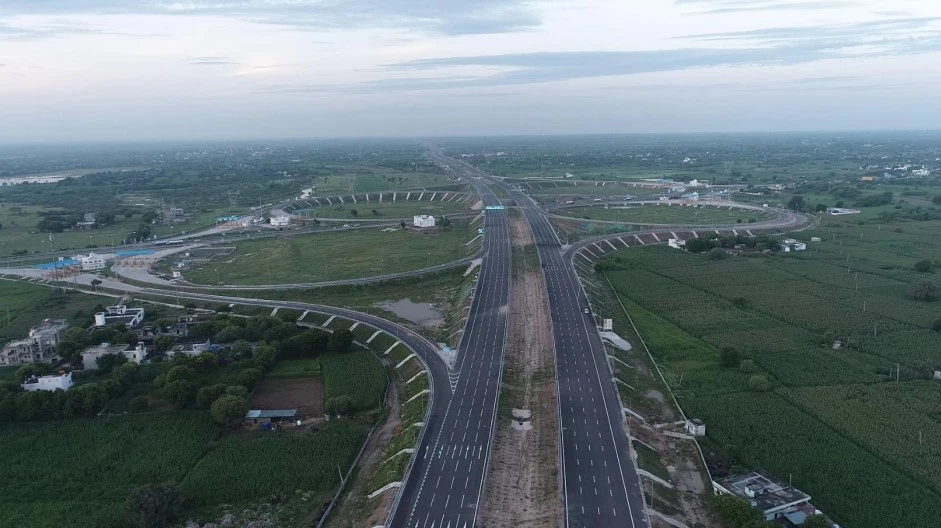
This project is built under “PM Gati Shakti” and “Samruddhi Mahamarg” to integrate infrastructure connectivity across India. Built in four phases, this Delhi-Mumbai Expressway route is shorter and faster than alternate routes via Delhi-Agra and Agra-Mumbai. Initiated in 2019 by Road Transport & Union Minister Nitin Gadkari in the presence of Sushma Swaraj, this expressway is set to be commissioned in 2024.
The Delhi-Mumbai Expressway is built in an 8-lane configuration. It can further be repurposed as a 12-lane configuration for future situations with a design speed of 120 km/hr. It is designed with 92 special amenities, such as hospitals, shopping complexes, hotels, and fuel stations, to enable comfortable passenger, freight, and electric vehicle movement. The Delhi-Mumbai Expressway will connect 12 major cities, including Jaipur, Udaipur, Mumbai, Ahmedabad, Vadodara, and Kota.
Project Background
The Delhi-Mumbai Expressway is the most critical corridor of the national highway network, connecting the national capital with the country’s financial capital. It was envisioned by Prime Minister Narendra Modi in 2018 under the “Samruddhi Mahamarg." This project was initiated by Union Road Transport & Highway Minister Nitin Gadkari in the presence of Sushma Swaraj in 2019. The Delhi Expressway is built under the umbrella of “Bharatmala Pariyojana Phase 1,” spanning 5 years with an estimated cost of INR 98,000 crores.
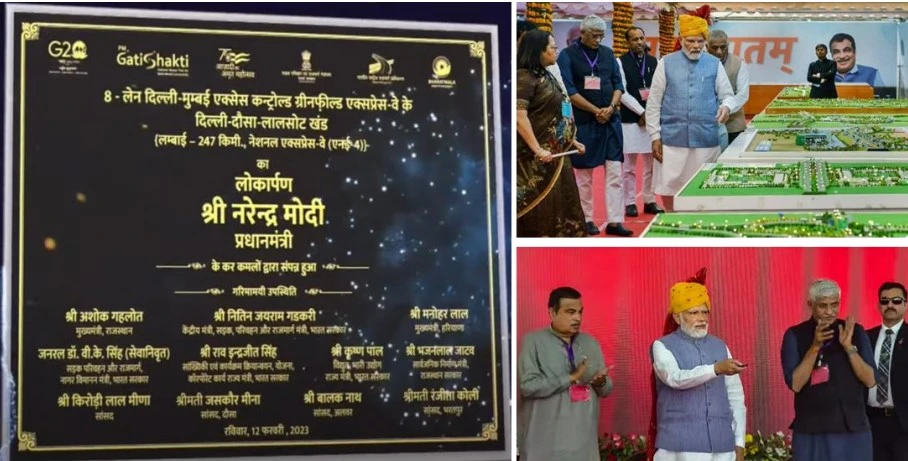
The government sources state that Phase 1 of Bharatmala Pariyogana involves the construction of a total 24,800 km-long corridor. The Delhi-Mumbai Expressway route map covers 5 major states: Haryana, Rajasthan, Madhya Pradesh, Gujarat, and Maharastra. Additionally, it connects 12 major cities across the country, including Kota, Bhopal, Ujjain, Indore, Vadodara, and Jaipur. Thus reducing the overall travel time.
This Delhi-Mumbai Expressway route will reduce the distance by 150km and travel time by 13 hours from the current 24 hours. The project is built by the National Highway Authority of India (NHAI) as the largest expressway in India. Initiated in 2019 and built-in four different phases, the Delhi-Mumbai expressway section will be completely open for passenger and freight movement in 2024.
Delhi Mumbai Expressway Route Map
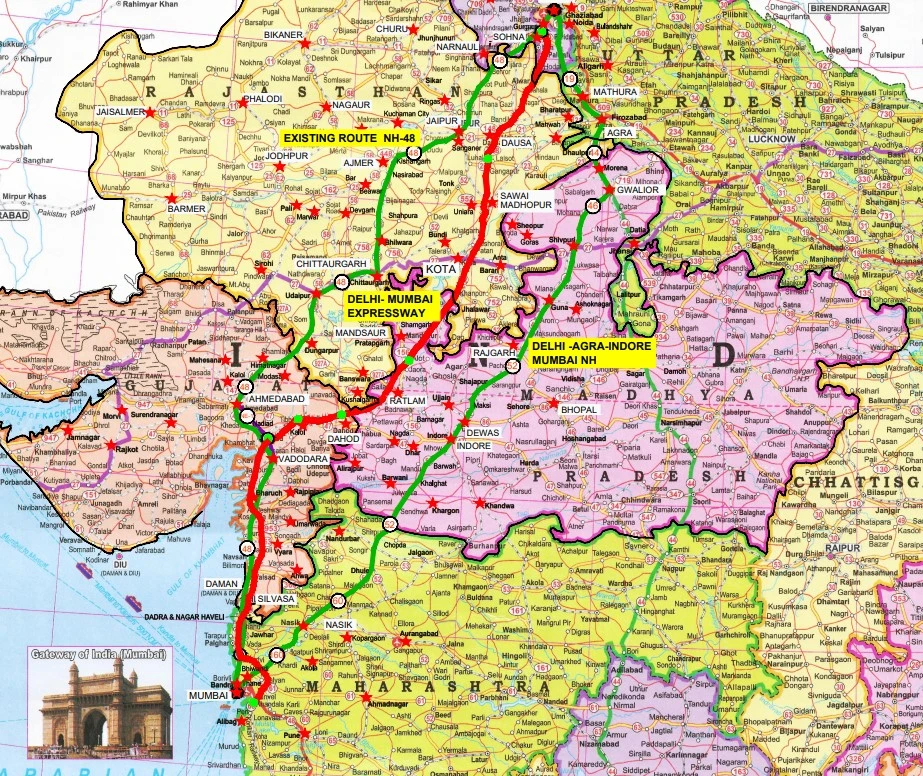
Delhi Mumbai Expressway Route
The Delhi mumbai expressway is 1386 km long connecting economic hubs Delhi, Haryana, Rajasthan, Madhya Pradesh, Gujarat and Maharastra. From the 1386 km, currently 630 km of the Sohna-Vadodara stretch, 245 km between Jalhar & Madhya Pradesh/Gujarat boarder and 293 km between Sohna, Dausa, and Sawai Madhopur is accessible for commute. The entire lenght will be accesible by March 2025 said Road Transport & Union Minister Nitin Gadkari.
40+ reviews
Find More Construction Projects and Tenders in India
Gain exclusive access to our industry-leading database of construction project opportunities with detailed project timelines and stakeholder information.
Collect Your Free Leads Here!
No credit cardUp-to-date coverage
Joined by 750+ industry professionals last month
Project Timeline
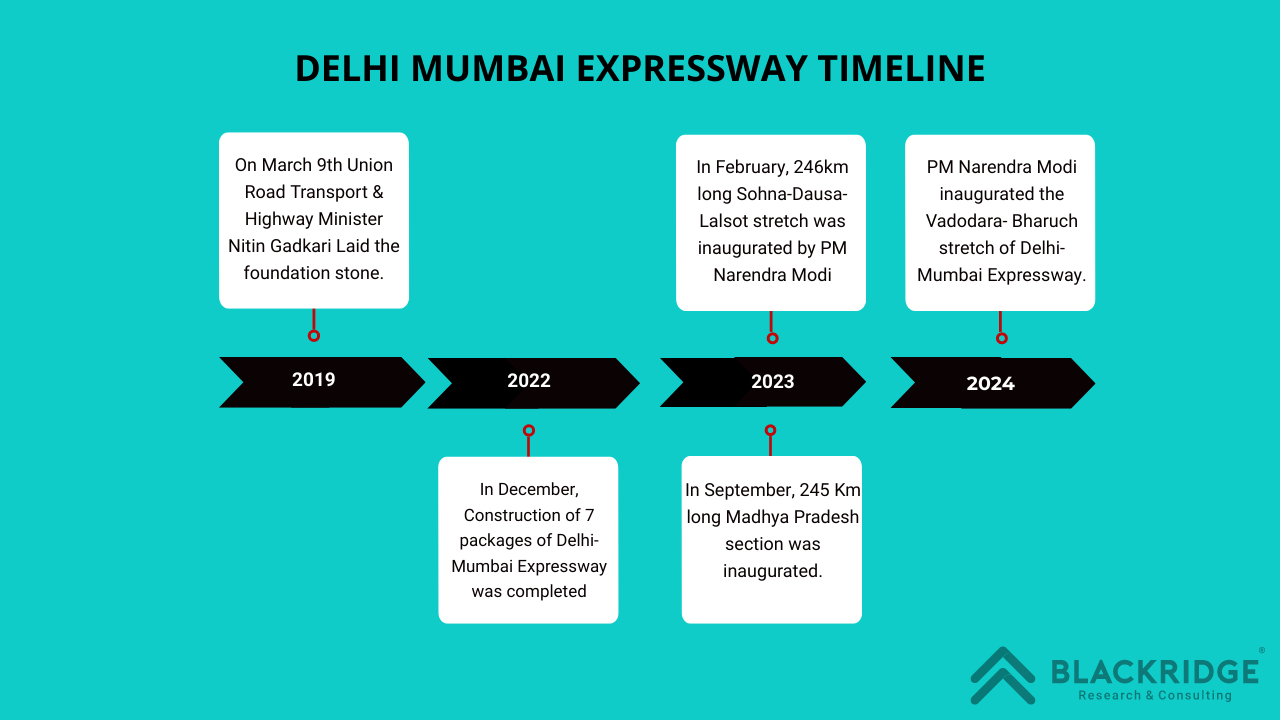
2025: October 2025, The entire lenght of Mumbai Delhi Expressway will be accessible for commute.
2022: March 2022, a 67km contract of Bandikui-Jaipur was awarded to GR Infraprojects Ltd
2021: In September, the Steel Bridge over the Narmada River near Bharuch in Gujarat was constructed in 32 months.
2021: In August, Sector 65—Faridabad—to Delhi Navi Mumbai Expressway link road was constructed.
2020: August 2020, contracts awarded of three packages of 59 km of the DND-Faridabad-KMP section to DRA Infracon-Virar
2018: PM Modi envisioned the Delhi-Mumbai industrial corridor, and in March, NHAI awarded a contract to build the Vadodara Expressway -Virar section in Gujarat.
Project Scope
The Delhi-Mumbai Expressway is developed with an 8-lane configuration with a provision to expand to 12 lanes to meet future capacity and travel time needs. This project was first announced in the Lok Sabha Election in New Delhi. Out of the 1,352 km-long expressway, 1,200 km of contracts are been awarded and constructed. This greenfield expressway network has been planned with 92-way side amenities at every 50-km interval. These include commercial facilities such as motels and dormitories for truck drivers, fuel stations, restaurants, and hotels for car and bus passengers to enable comfortable passenger and freight movement.
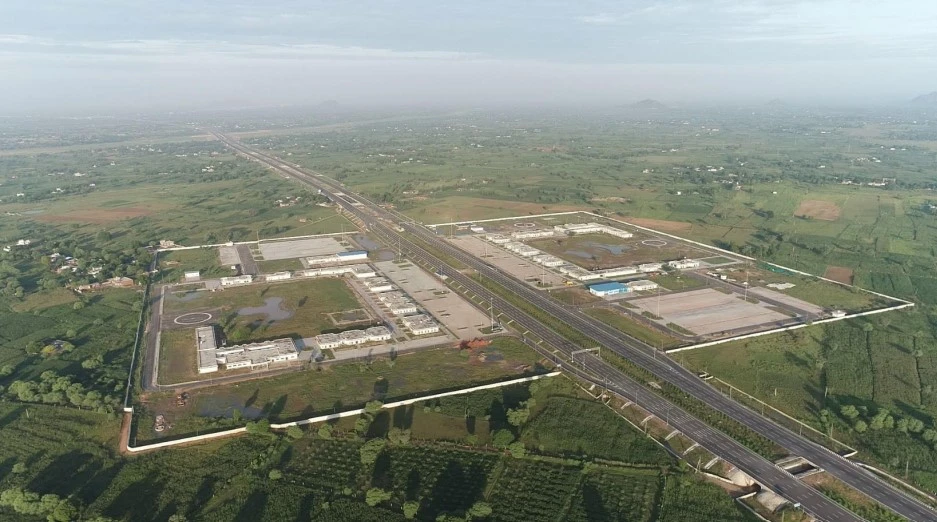
The Delhi-Mumbai expressway distance is about 1,352 km with a speed limit of 120km/hr. Thus reducing the logistics costs by 8–9%, the government thereby reduces overall travel time. This project is designed such that only 20 km of the entire project passes through reserve forests. Additionally, more than 10,00,000 trees are proposed to be planted along the corridor.
A government source states that more than 12 lakh tons of steel and 80 lakh tons of cement were used for this project. About 160km of the expressway passes through Haryana, connecting the state to Rajasthan, Madhya Pradesh, Gujarat, and Maharastra. About 374 km passes through Rajasthan connecting districts like Alwar, Bharatpur, Dausa, Tonk, and Kota. The 245 km of the Toal expressway in the state of Madhya Pradesh features a large-scale hill transformation with an iconic 600-meter elevated bridge constructed through Jhawda.
About 423km of the expressway is built across Gujarat, connecting cities like Dahod, Vadodara, Panchmahal, Surat, and Bharuch. This expressway will be connected to the Vadodara-Ahmedabad Expressway.
Delhi Mumbai Expressway Cost
State | Length (km) | Cost (crore) | Contracts Awarded (km) |
Delhi | 9 | 1,800 | 9 |
Haryana | 160 | 10,400 | 130 |
Rajasthan | 374 | 16,600 | 374 |
Madhya Pradesh | 245 | 11,100 | 245 |
Gujarat | 423 | 35,100 | 390 |
Maharashtra | 171 | 23,000 | 80 |
Total | 1382 | 98,000 (USD 11.72 billion) | 1228 |
The Delhi-Mumbai Expressway connects 6 major states, including Delhi. Additionally, it covers 12 major cities like Ahemadabad, Kota, Vadodara, Jaipur, Udaipur, and Mumbai. It is built in 2 sections. The first section of the expressway connects the Delhi-Dausa-Lalsot section. It is a part of the Delhi-Jaipur Expressway. The second section is the Vadodara-Ankleshwar section. This connects the Vadodara economic hub to Bharuch.
Delhi Mumbai Expressway Contractors
Delhi-Faridabad-Sohna
State | Length(km) | Concessionaire |
Haryana | 47 | M/s APCO Infratech Pvt. Ltd |
32 | M/s Centrodorstroy India Pvt. Ltd | |
Rajasthan | 67 | Mis KCC Buildcon Pvt. Ltd. |
31 | Mis Gawar Constructions Ltd. | |
79 | M/s H.G. Infra Engineering Limited | |
12 | M/s Larsen & Toubro Ltd. | |
28 | M/s GR Infraprojects Limited | |
29 | M/s CDS Infra Projects Limited | |
8 | M/s Dilip Buildcon Ltd Corporation | |
25 | M/s Dineshchandra R.Agrawal Infracon Pvt | |
Madhya Pradesh | 132 | M/s GR Infraprojects Limited |
62 | M/s Jiangxi Construction Engineering (Group) Corporation Ltd. MKC Infrastructure Ltd. (JV) | |
25 | M/s GHV (India) Pvt Ltd. | |
25 | M/s Larsen & Toubro Ltd. | |
Gujarat
| 30 | M/s Atlas Construction Pvt. Ltd., NKC (JV) |
55 | Mis GHV (India) Pvt Ltd |
Delhi-Vadodara
State | Length (km) | Concessionaire |
Gujarat | 52 | M/s IRB Infrastructure Developers Ltd. |
32 | M/s IRCON International Limited | |
31 | M/s Patel Infrastructure Limited | |
13 | M/s Ashoka Buildcon Limited | |
25 | M/s Sadbhav Engineering Pvt. Ltd. | |
37 | M/s GR Infraprojects Limited | |
62 | M/s Roadway Solutions India Infra Ltd. | |
Maharashtra | 26 | M/s GR Infraprojects Limited |
26 | M/s RKC Infrabuilt Private Ltd. | |
27 | M/s Montecarlo Limited |
Vadodara- Virar
State | Length (km) | Concessionaire |
Maharastra | 27 | M/s IRCON International Limited |
23 | M/s Agroh Infrastructure & Developer Pvt. Ltd. | |
10 | M/s Shivalaya Construction Ltd. |
40+ reviews
Find More Construction Projects and Tenders in India
Gain exclusive access to our industry-leading database of construction project opportunities with detailed project timelines and stakeholder information.
Collect Your Free Leads Here!
No credit cardUp-to-date coverage
Joined by 750+ industry professionals last month
Challenges During Construction
Land Acquisition
The cost of land acquisition was high compared to the overall civil cost of the Delhi-Mumbai Expressway. The existing corridor (brownfield) projects' upgradation and expansion were higher in cost. This added to the overall civil cost of this project.
Traffic Flow
Enabling the Delhi-Mumbai Expressway by optimizing the existing corridors through the traffic flow in major cities like Jaipur, Vadodara, Mumbai, Ahmedabad, and Kota proved to be a major challenge during construction.
Benefits of this Project
The Delhi-Mumbai Expressway is set to bridge infrastructure gaps and improve passenger and freight movement through national corridors and inter-corridors. Several benefits received through this project are listed below:
Improved Economy
The Delhi-Mumbai expressway will improve trade among different states and major cities, leading to increased trade and commerce thus boosting the Indian economy. Additionally, the amenities such as shops, hotels, and fuel stations built near major economic centers will provide a livelihood to these centers.
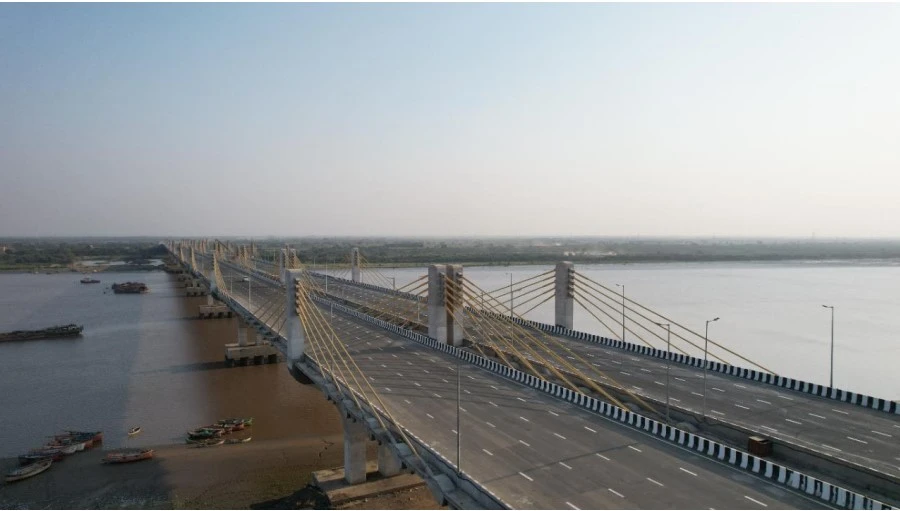
Employment Opportunities
The construction phase of the Delhi-Mumbai Expressway aims to generate several job opportunities, including maintenance and repairs. A source from the government says it aims to provide 50 lakh man-days during the construction phase.
Environment Friendly
Initiatives like planting 10,00,000 trees along the corridor, installing solar-powered lights at major structures and toll plazas, and planning a rainwater harvesting facility at every 500m of the highway minimized the ecological impact caused by the Delhi-Mumbai Expressway.
Improved Connectivity
The Delhi Mumbai expressway passes through 5 major states and several cities reducing the travel time to half and making passenger movement fast and comfortable. This project aims to improve the road infrastructure in India through well-connected roads thus, improving overall connectivity.
Enhanced Logistics Movement
The Delhi-Mumbai Expressway is expected to reduce logistics costs by 8–9% saving Rs 100,000 crore (USD 1 trillion). Additionally, 8 8-lane configuration ensures larger freight movement in a shorter time with reduced wear and tear of vehicles.
Delhi Mumbai Expressway Status
The Delhi Mumbai Expressway is now set to be fully operational in March 2026, spanning across six states between Delhi to Mumbai.
The Delhi–Mumbai Expressway is nearing completion on the Rajasthan–Delhi stretch, near the Mukundra Hills Tiger Reserve. The 4.9 km tunnel, with two parallel tubes of four lanes each, is expected to be operational by early December 2025, reducing travel time significantly and marking a major milestone in India’s infrastructure development.
The Delhi Mumbai Expressway is set to achieve 100% completion by October 2025 becoming fully operational for commuters. In 2025, new expressways are set to open for commute of passengers cutting down the travel time.
The Bengaluru-Chennai Expressway is 71 Km stretch that is toll-free for use and is set to be operational from August 2025 reducing the travel time between two cities from six hours to three hours.
On 9th April 2025, Ministry of Road Transport and Highways (MoRTH), announced that expressway connecting Gurugram to Vadodara is near to completion. About 1156 km of the 1386 km has been completed. Of this, about 756 km is already available for commuters.
Currently, Gurugram to Vadodara takes 20-22 hours travel time, however, once the expressway is open the travel time is expected to reduce to 10-12 hours. This eight-line expressway will connect Haryana, Rajasthan, Madhya Pradesh, Gujarat, and Maharashtra. The cost of this expressway is estimated as INR 1 lakh crore and can be expanded to a 12 lane expressway.
A tunnel near Mukundra Hills Tiger Reserve in Kota, Rajasthan is also a part of this expressway. Measures are been taken to reduce ecological impact and ensure wildlife safety.
The Nagpur-Goa Shaktipeeth Expressway India's longest with a stretch of 802 km starting from Pavnar, Wardha district, passing through 12 districts including Wardha, Hingoli, Nanded, Parbhani, Yavatmal, and Sindhudurg and concluding at Patradevi on the Maharashtra-Goa border. Once operational, this expressway will reduce travel time from 18-20 hours to just 8-10 hours.
On 16th December 2024, the National Highway Authority of India (NHAI) announced the inauguration of new 80 km stretch on the Delhi Mumbai Expressway, this stretch connects Kota and Bundi in Rajasthan. This new stretch is expected to reduce the overall travel time from hours to just 50 minutes.
As per the latest updates, about 327 km of the 373 km planned in Rajasthan is already functional, the entire Delhi Mumbai Expressway is expected to be completed by 2026. The stretch connecting Kota to Delhi is expected to be operational by next two months. The delay in the construction is driven by challenges like land acquisition and complexity of the large scale infrastructure project.
Two new bridges in the Delhi-Mumbai expressway are set to be commissioned on 12th November 2024. The six-lane highway and two bridges, one over the Gurgaon Canal and one over the Agra Canal, are ready for commute. The elevated section of the corridor passes through Okhla Vihar, Yamuna Khadar, and Batla House along the Yamuna riverbank.
The downward ramp section of the corridor was constructed near Maharani Bagh which will cross the road near the Ashram entrance to the DND flyover. The travel time from Maharani Bagh to Sohna is expected to be reduced from 2.5 hours to 25 minutes after the commission of the bridges and highway.
The 2 Gujarat packages was delayed due to land acquisition however, the first Gujarat package construction (28 km) began in April and the second package construction (23 km) began in July. Currently, 1136 km of the 1386 km of the Delhi Mumbai expressway is accessible for commute, this accounts to completion of about 82% of the construction.
Currently, 630 km of the 845 km Sohna-Vadodara stretch is accessible for commute, the entire stretch will be available by March 2025. Currently, the three links between Mumbai's JNPT (Jawaharlal Nehru Port Trust), Delhi' s (DND Flyway) and Uttar Pradesh's (Jewar Airport) is under construction. The entire Delhi Mumbai Expressway will be operational by October 2025. The Delhi- JNPT stretch once operational will reduce the distance by 180 km and travel time by 50%.
Delhi Mumbai Expressway Completion date
The Delhi Mumbai Expressway, is set to 100% completion by October 2025, said the Road Transport & Union Minister Nitin Gadkari. The expressway will reduce the travel time for commuters across Delhi, Rajasthan, Maharashtra, Madhya Pradesh, Haryana, and Gujarat.
Conclusion
The Delhi-Mumbai Expressway distance is about 1352 km, connecting 5 states and 12 major cities, enabling faster passenger and freight transport. Built by NHAI through several contractors, this project will be the longest expressway in India. This project will reduce travel time, and boost economic activity and trade. Additionally, it focuses on sustainability through eco-friendly features like solar power, rainwater harvesting, and planting trees along the expressway corridor.
Several other road infrastructure projects like Delhi Dehradun Expressway, KMP Expressway (Western Peripheral Expressway or Kundli–Manesar–Palwal Expressway (KMP Expressway), Mumbai Nagpur Expressway, Dwarka Expressway, and Yamuna Expressway are planned and executed ensuring improved connectivity and comfortable movement of freight and passengers across India.
Connect with decision-makers of construction projects in India for business opportunities.
Subscribe to upcoming and ongoing construction projects and tenders database in India to get access to reliable and high-quality insights on upcoming, in-progress, and completed construction/EPC projects across India.
Our user-friendly platform provides essential details, timely updates, key stakeholder contact information, and business opportunities tailored for engineering companies, industry professionals, investors, and government agencies.
Start a free demo to take your business to the next level!







Leave a Comment
We love hearing from our readers and value your feedback. If you have any questions or comments about our content, feel free to leave a comment below.
We read every comment and do our best to respond to them all.